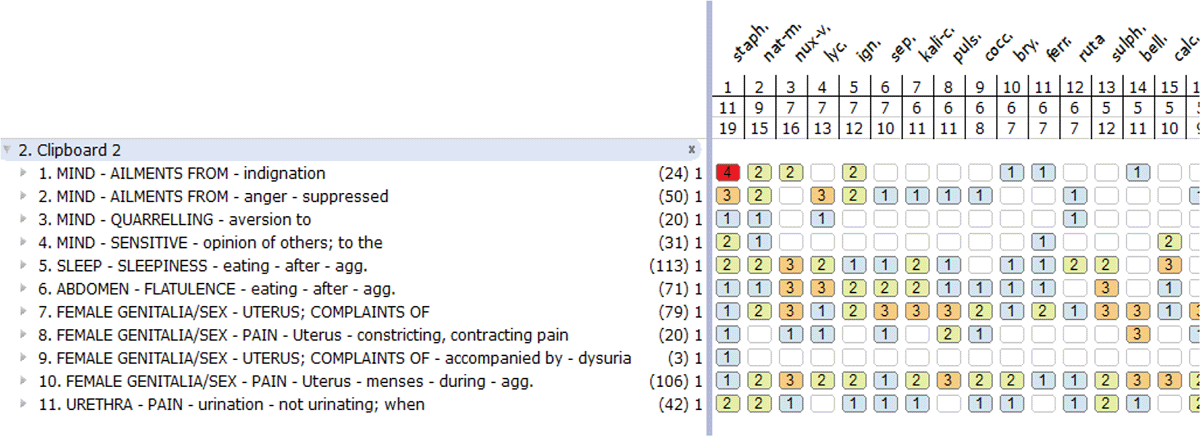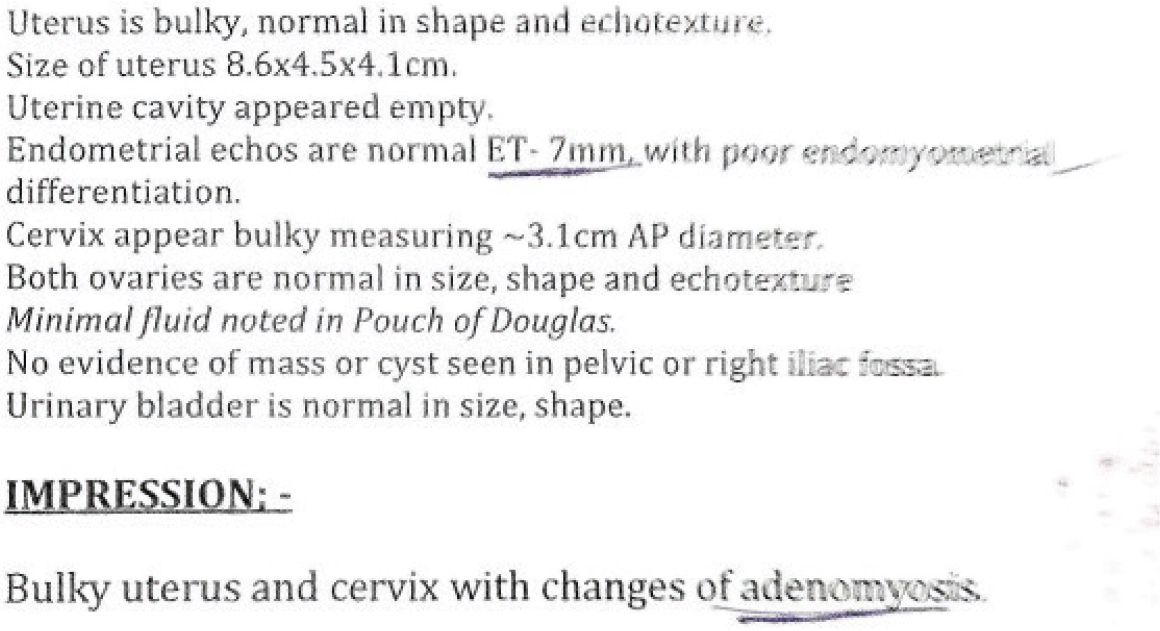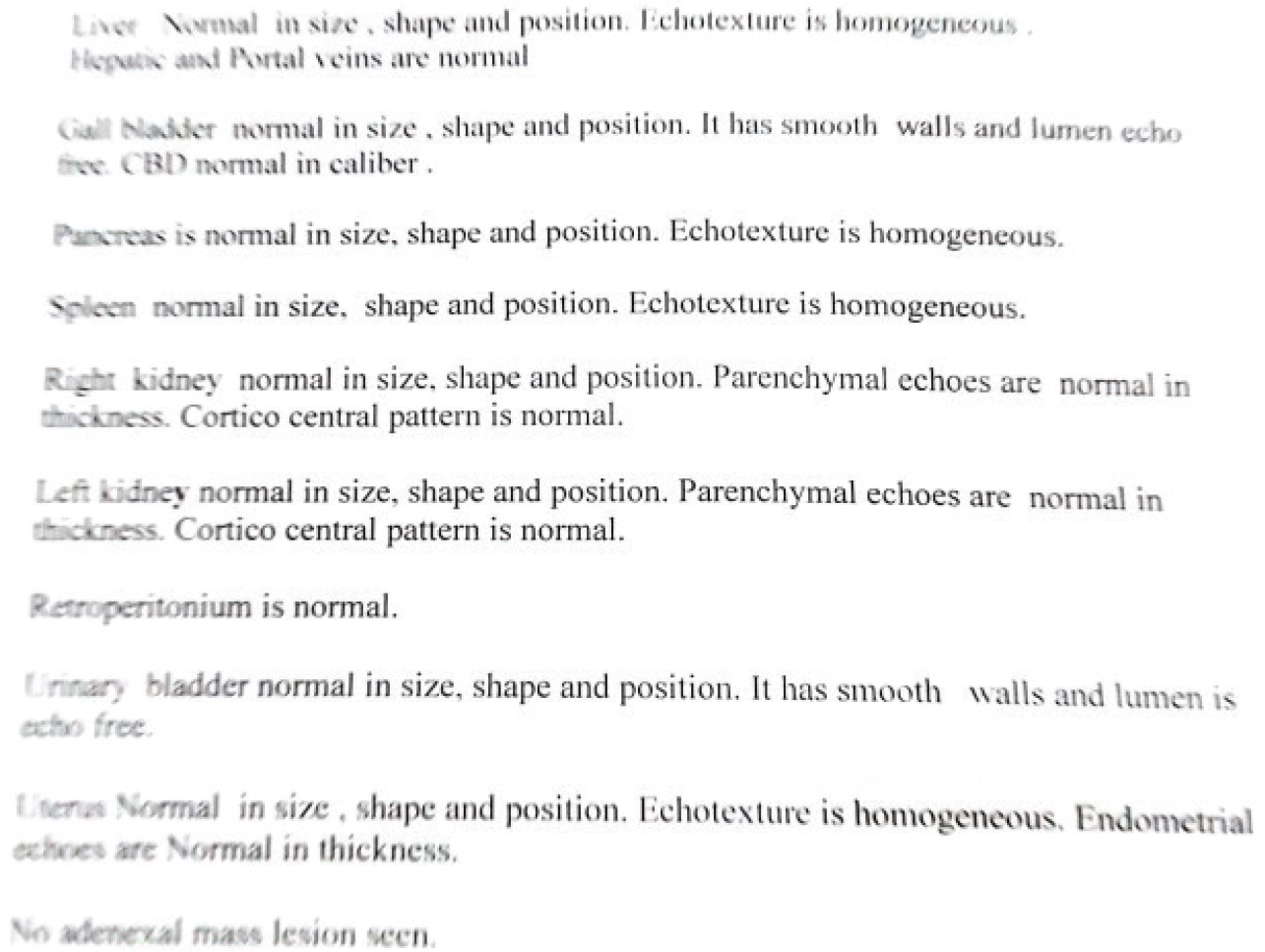
Integrative Medicine Case Reports, Volume 5, Issue 1 (January), 2024
Homoeopathic Treatment of Adenomyosis: A Case Report
KEY WORDS |
ABSTRACT |
|
Adenomyosis
|
Adenomyosis is a medical disorder where ingrowth of the endometrial tissue occurs, directly into the myometrium, resulting in uterine thickness. Clinical features of adenomyosis commonly includes menorrhagia and dysmenorrhea. The only definitive treatment for adenomyosis is a hysterectomy. This invasive procedure can avoidable with homoeopathic treatment. A 45-year-old female suffering from Adenomyosis with radiological evidence is presented here. Clinically patient reported with complaining of pain in lower abdomen and heavy painful menstrual bleeding for 2 years. After a thorough clinical evaluation, a constitutional homoeopathic medicine, i. e., Staphysagria was prescribed in increasing potency (up to Q10), when needed. Follow up assessment was done and a complete resolution of her presenting complaints was noted at the completion of the treatment. This case report proposes homoeopathic treatment as a feasible complementary or alternative therapy and emphasises the importance of repertorization in individualised homoeopathic prescription.
doi: 10.38205/imcr.050131 |
|
*Corresponding Author:
|
Introduction
Adenomyosis is a medical disorder defined by the proliferation of cells on the inside of the uterus (endometrium) that are atypically distributed among the cells of the uterine wall (myometrium), resulting in uterine thickness. Endometrial tissue is entirely functional in people with adenomyosis, in addition to being misplaced. During each menstrual cycle, the tissue thickens, sheds, and bleeds (1).
The illness is most common in women between the ages of 35 and 50 years, but it can also afflict younger women (2). Adenomyosis patients frequently report with painful menstruation (dysmenorrhea), copious menstruation (menorrhagia), or both. Other symptoms include pain during sexual intercourse due to an enlarged and tender uterus, frequent urination, and infertility (3).
Basal endometrium penetrates hyperplastic myometrium fibres in adenomyosis. The basal layer, unlike the functional layer, does not go through regular periodic changes during the menstrual cycle (4,5). Adenomyosis can cause adenomyoma by involving the uterus in a localized manner. The uterus grows bulkier and heavier with diffuse involvement (6).
Adenomyosis can be found together with endometriosis; it differs in those patients with endometriosis present endometrial-like tissue located entirely outside the uterus. In endometriosis, the tissue is similar to, but not the same as, the endometrium. The two conditions are found together in many cases yet often occur separately (7,4). Adenomyosis frequently requires surgical intervention to be cured (8), and hysterectomy is considered one of the main means to treat adenomyosis (9). This surgical operation, however, can be avoided with homoeopathic treatment. Various homoeopathic medicines like Arsenicum album, Nux vomica, Secale cor, Lachesis mutus, Medorrhinum, Pulsatilla, Sepia officinalis, Thuja etc can be useful in treatment of adenomyosis (8).
Case Presentation
A case of 45 years old female patient presented to the Outpatient department of National Institute of Homoeopathy on 04/09/2021 with complains of pain in lower abdomen and heavy painful menstrual bleeding, flatulence and painful urination for last two years. Character of abdomen pain was constructive.
History of present complaints: Patient was completely better 2 years back, than gradually pain in lower abdomen was felt, along with flatulence and painful urination. Then from last one year a heavy menstrual bleeding also presents in each menstrual cycle. She had allopathic treatment for her complaints without any significant relief.
Past History: She had chicken pox in her childhood. She also had suffered from urinary tract infection (UTI) 5 years back.
Family History: Her mother had suffered from rheumatoid arthritis and father from diabetes mellitus.
Physical General: Her appetite was moderate and she had no specific desire or aversion in food. She had distension of abdomen especially after eating. She had painful urination. Her stool was offensive with pain in abdomen especially after eating, her thirst levels week less and thermal reaction was chills. She felt sleepy more after eating.
Mental Generals
She was a housewife and not happy with her family members and their opinion. Sometimes she gets angry but unable to express. Refrain from any arguments and quarrel, very sensitive to other people’s opinions; easily disturbed by minor negative comments.
Investigation
TVS lower abdominal sonography reveals:
• Uterus is bulky, normal in shape and echotexture.
• Size of uterus: 8.6 × 4.5 × 4.1 cm
• Uterine cavity appeared empty.
• Endometrial echos are normal ET- 7mm, with poor endomyometrial differentiation.
• Cervix appear bulky measuring 3.1 cm (AP diameter)
• Both ovaries are normal in size, shape and echotexture.
• Minimal fluid noted in Pouch of Douglas.
• No evidence of mass or cyst seen in pelvic or right iliac fossa.
• Urinary bladder is normal in size and shape.
Results shows bulky uterus and cervix with changes of Adenomyosis [Supplementary file- 1].
Diagnostic Assessment
This case was diagnosed as Adenomyosis on the basis of clinical assessment and investigation reports. The diagnosis comes under specific code, GA11, in ICD-11 for Mortality and Morbidity Statistics, under Diseases of genitourinary system—which depicts Adenomyosis (10).
Case Analysis
After detailed case taking, analysis and evaluation was done and a case totality was constructed. The symptoms were taken for repertorisation as follows:
• Ailment from indignation
• Sensitive to opinion of others
• Ailment from Anger suppress
• Quarrelling aversion
• Sleepiness after eating
• Flatulence worse after eating
• Pain in uterine region, worse during menstruation
• Painful urination, more when not urinating
In this case, repertorisation was carried out by the software RADAR OPUS 3.1.5, using Synthesis Repertory (11). After repertorisation, the top ranked medicines Staphysagria, Natrum Muriaticum and Nux Vomica. Repertorial result shown in Figure 1.

Figure 1: Reportorial sheet.
Therapeutic Intervention
Considering the repertorial totality and consultation with Materia Medica, Staphysagria was selected as individualised homoeopathic remedy for this case. Baseline prescription: Staphysagria Q1/AD followed by Staphysagria Q2/AD was prescribed for 60 days. Advised for healthy diet and to take plenty of water.
Follow Up/Timeline: After receiving the initial prescription (September 04, 2021), the patient responded favourably, pain abdomen slightly diminished and a substantial decrease in menstrual complaints was observed. Although her gastric symptoms did not improve much initially but it was improved on subsequent visits. Clinically, she was entirely well after the sixth visit (which was 8 months following the initial prescription); No pain in abdomen or during micturition was there; menstrual cycle was regular and no heavy bleeding was observed. Her gastric symptom such as flatulence after eating also improved significantly. No new symptoms had appeared further, and her previous complaints did not worsen. Although transvaginal sonography couldn’t be obtained but whole abdominal sonography was performed on June 9, 2022 and the results were normal [Supplementary file- 2], which corresponded to the clinical improvement.
Discussion
Homoeopathic treatment of adenomyosis, a case report over the patient who was suffering from pain in lower abdominal region with profuse menstrual bleeding noted through TVS lower abdominal sonography. Individualized Homeopathic Medicines were prescribed on totality of symptoms with the help of synthesis repertory [Radar opus version 3.1.5].
The patient was treated with a single constitutional homoeopathic medicine, i.e., Staphysagria (upto Q10), which was selected on the basis of totality of symptom and proper reportorial analysis. This case was presented with radiological evidence (USG) bulky uterus and cervix with changes of adenomyosis. A follow-up was performed, which demonstrates significant clinical improvement of the patient. Total resolution of symptom was observed at end of the treatment, which shows efficacy of individualised homoeopathic treatment. In a broader interpretation of similar, remedy is selected for totality of symptoms both characteristic of the dominant constitutional and from the synthesis repertory. The efficacy of Staphysagria in treating gynaecological disorders was also shown in one study, where the medicine (i.e., Staphysagria) was chosen on the basis of patient’s individuality and resulted in a complete resolution of hyperplastic endometrium from hyperplastic condition to normal thickness (12).
The medicine was prescribed here in fifty millesimal potencies. The duration of timeline was one of the major limitations in this case study. This case study is limited to a single case, which can be another limitation of this study. However, data of this case report may also be helpful in the planning of further development of case series. This case report suggests homoeopathic treatment as a promising complementary or alternative therapy and emphasizes the need of repertorization in individualized homoeopathic prescription.
There hasn’t been sufficient study on homoeopathic therapy of Adenomyosis, however few studies show promising outcome of individualised homoeopathic treatment in Adenomyosis cases (13,14). Therefore, the extent of homoeopathy needs to be investigated through large-scale pilot studies or randomised controlled trials, and the instance that is being presented here can be used as literature evidence for further research.
Conclusion
This case study features an adenomyosis patient that responded well to treatment using individualised homoeopathic medication. This case study highlights the requirement of repertorization in homoeopathic prescriptions and offers homoeopathic treatment as a feasible complementary or alternative therapy in cases of gynaecological disorders like adenomyosis. However, more well-planned research is needed to validate homoeopathy’s effectiveness in treating adenomyosis.
Authors’ Contribution
SV, AKT: Data acquisition, concept/design and manuscript writing; KD: Analysis and interpretation of data, reviewing and editing.
Each author has given their consent for the final version to be published and agrees to be responsible for all parts of the work to ensure that any concerns regarding the accuracy or integrity of any component of the work are duly investigated and addressed.
Informed consent
The patient willingly gave her consent for publication of this case report.
Source of funding
None.
Conflict of interest
None.
Received Date: 02-10-2023; Revised Date: 01-01-2024
Accepted Date: 09-01-2024
References
1. Gunther R, Walker C. Adenomyosis. InStatPearls [Internet] 2022 Jun 21. StatPearls Publishing.
2. Brosens I, Gordts S, Habiba M, Benagiano G. Uterine cystic adenomyosis: a disease of younger women. Journal of Pediatric and Adolescent Gynecology. 2015 Dec 1;28(6):420–6.
3. Konar H. DC Dutta’s Textbook of Gynecology. 8th edition. JP Medical Ltd; 2016.
4. Katz VL. Comprehensive gynecology. 5th Edition. Philadelphia PA: Mosby Elsevier; 2007.
5. Leyendecker G, Herbertz M, Kunz G, Mall G. Endometriosis results from the dislocation of basal endometrium. Human Reproduction. 2002 Oct 1;17(10):2725–36.
6. Struble J, Reid S, Bedaiwy MA. Adenomyosis: a clinical review of a challenging gynecologic condition. Journal of minimally invasive gynecology. 2016 Feb 1;23(2):164–85.
7. Lazzeri L, Di Giovanni A, Exacoustos C, Tosti C, Pinzauti S, Malzoni M, Petraglia F, Zupi E. Preoperative and postoperative clinical and transvaginal ultrasound findings of adenomyosis in patients with deep infiltrating endometriosis. Reproductive sciences. 2014 Aug;21(8):1027–33.
8. Salauddin M, Singh PK, Singh S, Chhabra APS. Adenomyosis and its homoeopathic management. International Journal of Homoeopathic Sciences 2020;4(4):15–16.
9. Ajao MO, Brito LG, Wang KC, et al. Persistence of symptoms after total vs supracervical hysterectomy in women with histopathological diagnosis of adenomyosis. Journal of Minimally Invasive Gynecology. 2019 Jul 1;26(5):891–6.
10. International Classification of Diseases Eleventh Revision (ICD11), World Health Organization (WHO) 2019/2021 https://icd. who.int/browse11. Licensed under Creative Commons Attribution-No Derivatives 3.0 IGO licence (CC BY-ND 3.0 IGO)
11. Schroyens F. Repertorium Homeopathicum Syntheticum. Synthesis Treasure Edition 2009V [RADAR OPUS 3.1.5. software]
12. Das T, Chattopadhyay R, Saha S. Individualised homoeopathic approach for simple endometrial hyperplasia presenting with post-menopausal bleeding – A case report. Indian J Res Homoeopathy 2022;16(1):61–67.
13. Ponnam HB, Suryanarayana YS. A Case of Adenomyosis of the Uterus. Homœopathic Links. 2014 Jun;27(02):96–9.
14. Thakur AK, Priyanka KM. A clinical case study of homoeopathic treatment of adenomyosis [Internet]. Homoeopathy360 [cited on 21-12-23]. Available from: https://www.homeopathy360.com/a-clinical-case-study-of-homoeopathic-treatment-of-adenomyosis/
Supplementary file 1

Supplementary file 2
